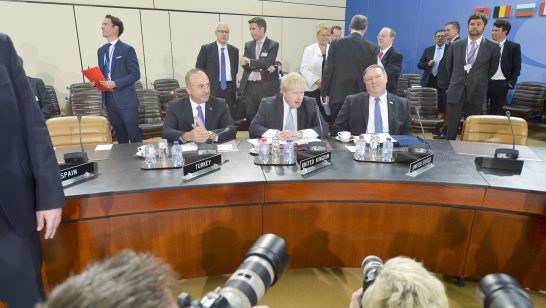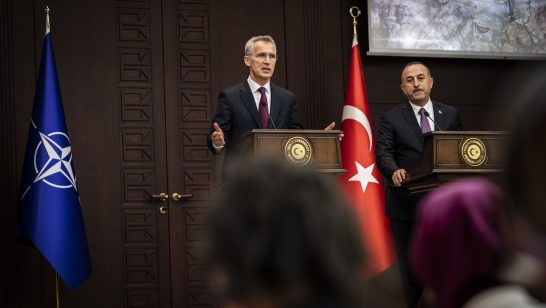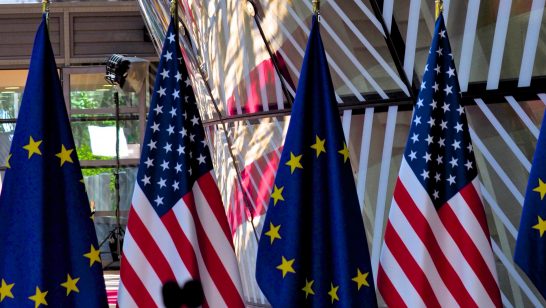
The scenes at Kabul International Airport, as the Afghan government fell to the Taliban in August, will linger in the world’s memory for decades to come. The debacle of the chaotic withdrawal from Afghanistan cannot simply be confined to that country. It sent tremors throughout the world and has opened a new chapter in the balance of power among major actors on the globe. It has triggered faultlines on a regional and global scale that are reminiscent of critical inflections which have shaped world politics before. The question is whether the world is back in realpolitik struggles harking back to distant times, or whether it is undergoing a global restructure including new forms of multilateralism in a new age.
Passions over the ‘Afghanistan syndrome’ and its consequences have not cooled. That said, just a month later, new shockwaves appeared when the AUKUS nuclear-powered submarine deal was announced in mid-September by the US, UK and Australia, followed by the QUAD meeting in Washington of those three countries along with Japan, in Washington D.C. ten days later. The AUKUS agreement pact has also spurred intense global reactions from Paris to Brussels to Beijing and has put strategic rivalry into high gears in the Indo-Pacific theatre. The centre of gravity of this competition is shared this time around by Canberra, which has upped the ante in the region in terms of pressure on and deterrence of China.
Implications for NATO
NATO was not unprepared for the potential challenges and opportunities that China represents. The Alliance had begun to discuss these long before it made its first explicit mention of China, in the short NATO communique issued after the London Leaders Meeting of December 2019. But these discussions were confined to behind-the-scenes consultations and strategic reports.
Moreover, NATO has had other priorities. While discussions of China were already beginning to brew, Russia became the main antagonist for NATO after its 2014 occupation and annexation of Crimea and its destabilising acts in the Donbas region of Ukraine. The multi-theatre Russian threat was in many ways galvanising for NATO in terms of increasing unity and solidarity among Allies. Meanwhile, the rise of ISIS also preoccupied NATO for much of this time.
While NATO has been largely unified on Russia and on counterterrorism, it has had to deal with tensions within the transatlantic relationship stemming from the disastrous ‘America first’ discourse of the Trump era, which has left a continued imprint in transactions between the US and Europe at large. Biden’s victory was a relief for many in Europe, who thought finally, ‘America was back’ on the international stage, with a renewed interest in multilateralism. Their more relaxed feelings were questioned by those sceptics in Europe who have been tracking the lines of continuity in Washington’s strategic thinking, which date back to the early 2000s. The creeping process of the US isolationist set of attitudes started during the George W. Bush period, and accelerated under Obama, reaching its pinnacle at the Trump administration. One of the visible fallouts for the European allies was for them to seek more strategic autonomy vis-à-vis the US. Nevertheless, it was worth giving the benefit of the doubt to the new US administration, which impressed the world by ratifying the Paris Climate Accord as its first action.
US actions started to dilute the impact of Biden’s soothing words as early as April 2021 when Biden announced US forces would leave Afghanistan by 11 September 2021. NATO Allies were cornered to the point of ‘adjusting together’ for an early, and later disorderly, withdrawal from it. The scenes of traumatic evacuation efforts at the Kabul airport came just weeks after the series of summit meetings in June 2021 which had increased the hopes in stronger transatlantic unity and cohesion to meet the emerging challenges of the new security era. Those summits gave the impression that the building blocks of a renewed transatlantic compact, a concept which we elaborated on before the June 2021 Summits, were being solidly laid at a period when strategic rivalry among the US, Russia and China is sharpening.
Updating NATO’s strategic concept and finalising the EU’s Strategic Compass
After Afghanistan and AUKUS, several factors should be considered in updating NATO’s strategic concept and finalising the EU’s Strategic Compass:
NATO’s 2030 Reflections Process – in which one of us participated – is still the right point of departure. The ultimate goal should be to reinforce Alliance unity, solidarity and cohesion with increasing political consultation and coordination, in order to ensure it has the relevant instruments for all security challenges and to move towards a stronger political role for the Alliance. Macron’s famous comment that NATO was “braindead” was prompted by his frustration regarding a lack of consultation on Syria, which was perceived as sidelining France in a geography where it has strong historical ties (although France has itself blocked certain security discussions within NATO). To make consultation more of a reality, Allies should be candid in their words and deeds, but ultimately with a common understanding that NATO is the essential forum of Allied consultations on the full spectrum of security issues, even when NATO may not be the first responder.
Secondly, there is an urgent need to resolve a number of bilateral differences between NATO Allies, including serious issues between Turkey and the United States, and latterly between France and the US. Neglecting or freezing these issues would eventually harm the very fabric of their relations and the unity and cohesion of the Alliance.
For the EU, aspiring to “strategic autonomy” could be seen as a valid and legitimate goal. Nevertheless, it needs to be put into a realistic perspective. Fundamentally, the EU lacks many key military capabilities and enablers in quantity and quality, including strategic airlift, air-to-air refuelling, Joint Intelligence, Surveillance and Reconnaissance (JISR), and sixth-generation capabilities in different military domains. Recognising the fact that NATO will remain as the cornerstone of the European security and defence, the EU’s aspirations for “strategic autonomy” should be pursued by strengthening the European pillar within NATO. This should be done with the fullest possible involvement of non-EU Allies, an unfulfilled pledge on the side of the EU which is yet more urgent after Brexit.
There already exists an acquis within NATO on to resurrect the European pillar and adapt it to meet today’s challenges. A redesign of the European pillar is therefore necessary. This should take its cue from the relevant recommendations in the NATO 2030: United For A New Era report with a view to creating renewed synergy between NATO and the EU. It is worth working to reconcile the European Intervention Initiative spearheaded by France in 2017 with the competent structures and capabilities of NATO, to maintain coherence and harmony within a restructured European pillar within the Alliance. This common effort should extend to both political and military domains, in the spirit of the NATO 2030 Report. This needs to be done as a mutual initiative by both sides working cooperatively. In that respect, the approach to NATO that will be taken by France and Germany (under its new government) will be of crucial importance.
With the existing and emerging security challenges posed by Russia, China, and the disruptive acts of non-state actors, NATO and the EU should consolidate and solidify their existing cooperation. While doing so they should revisit some of the ideas that had been floated in the past, especially those on “Reverse Berlin Plus” or “Berlin Plus 2.0” by also giving NATO assured access to the EU’s capabilities, when needed.
To overcome the conundrum presented by the notion of Reverse Berlin Plus, the EU should set in unequal terms its limit on strategic autonomy and demonstrate a much more flexible attitude, thereby lifting barriers to further NATO-EU cooperation. Ambivalence in that respect is not an option. Equally important to surmount the narrow corridors of institutional impediments is the continuing urgent need to overcome the imbroglio impeding a comprehensive settlement in Cyprus under the aegis of the UN. What seems necessary here is for the EU to seek to play a constructive role, thus avoiding sidelining any player with a high stake during the settlement process. Reenergised novelty, creativity, and credibility should be the guiding tenets in a renewed endeavour toward settlement.
The opinions articulated above represent the views of the author(s) and do not necessarily reflect the position of the European Leadership Network (ELN) or any of its members. The ELN’s aim is to encourage debates that will help develop Europe’s capacity to address the pressing foreign, defence, and security policy challenges of our time.
Image: Flickr, NATO




